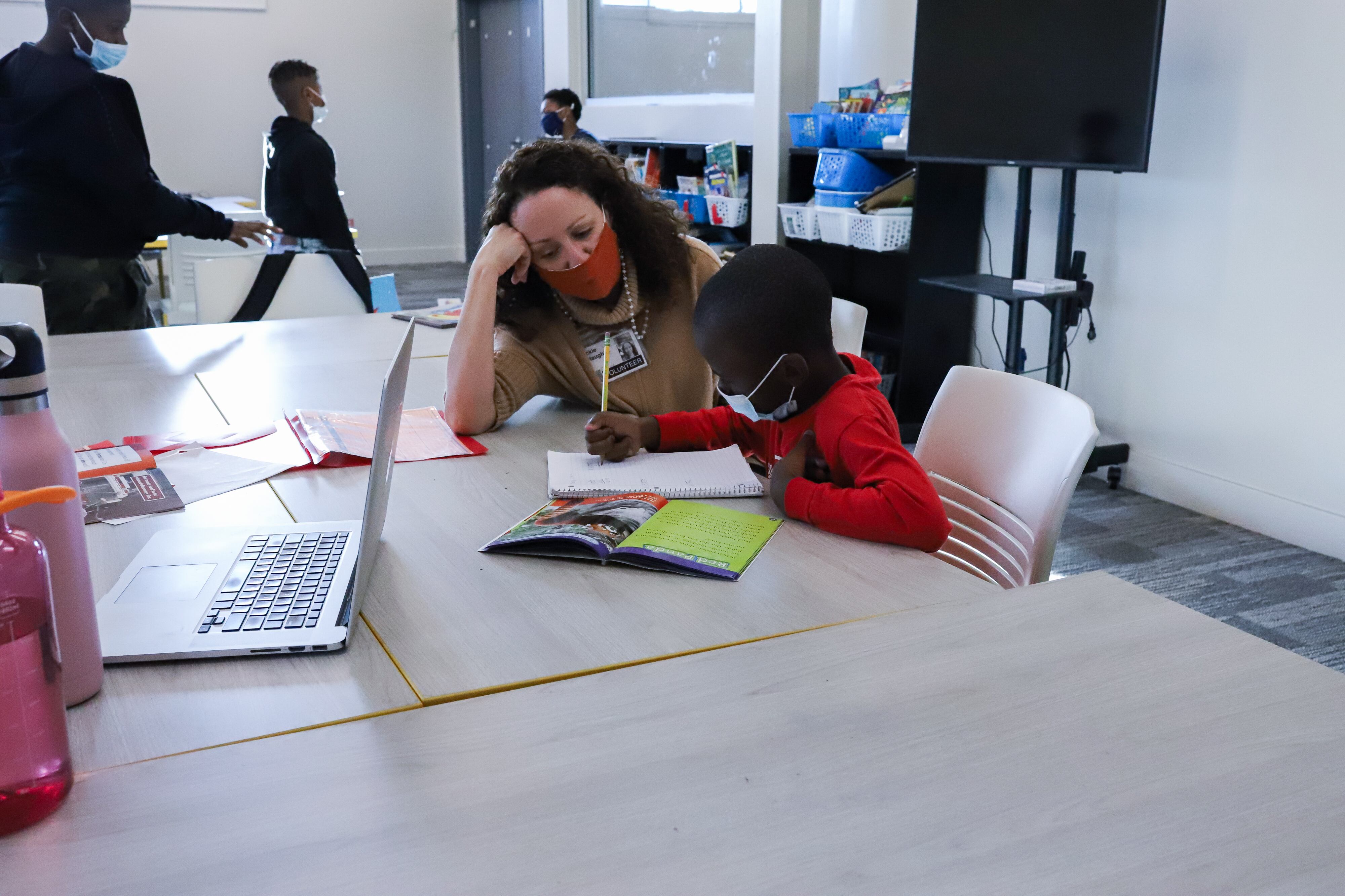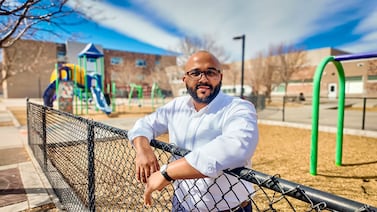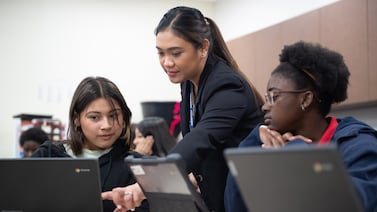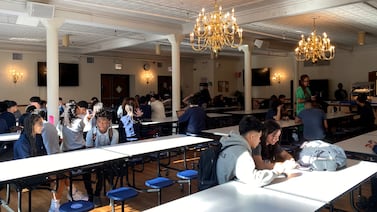When tutor Natalie Koenig answered a recent call, the student on the line was facing a familiar problem: Her algebra homework wasn’t clicking.
She was calling in to the Rose-Hulman Institute of Technology’s free tutoring hotline for help from university students like Koenig, who take math and science questions from sixth to 12th grade students every evening.
After Koenig helped her through some simpler algebraic concepts, the middle schooler nailed her first problem — and was eager to do more.
Koenig then told her to pick the hardest question on the page. Working through it, Koenig said, the student’s confidence grew.
“She asked if she could call again to get help from me,” Koenig said. And the student did call Koenig later that week for more help.
Since its start with a handful of phone lines more than 30 years ago, the university’s AskRose tutoring program has expanded into video calls, emails, and chat support. The Lilly Endowment-funded program recently added earlier hours to reach more students after finding that between 20 and 40 students were calling every day before the hotline even opened.
Over the past year, free tutoring programs have grown in Indiana as the state leans on intensive, one-on-one help as a solution to academic declines and drops in test scores following COVID. Nationwide interest in such tutoring efforts has grown as well.
Established tutors say working with trained tutors or teachers can go a long way to help students rebuild academic foundations and foster the skills and self-confidence they need to succeed. Indiana education officials have also touted the early successes of tutoring.
“Slowing down and rebuilding the foundation that fell apart is where we’re finding the most success,” said Teresa Lubovich, owner of Poulsbo Tutoring, which works with students in 10 states. For example, she’s turned mastering the times tables into a competition for her students in order to rebuild a basic skill that’s critical to other math lessons.
But there are challenges ahead for tutoring programs, too. Students report feeling more lost and frustrated than before COVID, meaning tutors must cover more content in their sessions while also creating a safe and supportive environment.
“Tutoring is a lot about the content, but it’s also about the relationship you build with the child,” said Ishmael Brown Jr., a tutor, teacher, and president emeritus of the National Tutoring Association. “They don’t care what you know until they know that you care.”
Tutoring helps students practice skills
Compared to before the pandemic, more students are calling in to AskRose not knowing where to start on their homework, said Kim Lund, the service’s assistant director for operations and education. This is especially noticeable in math, where new concepts build on past ones that students may have missed during the years of virtual learning.
“What I missed in fourth and fifth grade is impacting sixth grade,” Lund said. “You are finding school districts everywhere are looking for solutions to help kids catch up on what they lost over the years.”
Therefore, it’s important for tutors to engage students by helping them connect the work in front of them to a concept that’s familiar from past classroom lessons, she said.
AskRose tutors, who are all students at the engineering and technology school, have textbooks handy to help them tackle questions, and rely on each other for subject-matter expertise. Around 19 tutors work during the center’s peak hours from 7 p.m. to 10 p.m., and they’re paid for their time.
Lund said tutoring is well-suited to reinforcing skills through accurate practice, but that it’s not a replacement for learning the skill for the first time in a classroom setting.
Good tutoring helps students work through their questions without providing the answers instantly — something she said some students have gotten used to while learning on devices.
“They say practice makes perfect, but practice makes permanent,” Lund said. “Perfect practice makes perfect.”
Other hallmarks of a quality tutoring program include consistency, availability, and accountability, said Amanda Case, assistant professor of counseling psychology at Purdue University.
Education leaders have increasingly touted “high-dosage” tutoring, which relies on pairing students with one teacher over the course of several sessions for the best results.
But Case said that high-dosage tutoring ideally takes place more than three times a week. Tutoring should also be accessible to all students who need it, rather than available only to families who can afford it and have a way to attend. And it should come with a method of evaluation, she said.
It’s likely too soon to tell if the new state programs are effective and accessible, she said. They take many different forms, including free virtual tutoring for all students in Indianapolis Public Schools, as well as state grants of $500 to $1,000 for families to choose their own tutoring providers.
“You can give students a ton of ineffective tutoring and it won’t help students do anything,” Case said of the state’s hopes for tutoring. “High-dosage tutoring performed by professionals — it does hold quite a bit of promise.”
More students are feeling lost
Tutors say students need help beyond academics, too.
They’re not only more frustrated than before, said Lund, but facing pressure to return to “normal” after COVID.
Lubovich, owner of Poulsbo Tutoring, said many families also opt for organizational coaching for their students. This covers executive functioning, planning, and meeting deadlines, in addition to content tutoring.
Students may need this kind of help with motivation and organization after several years of receiving passing grades for far less effort, she said. But families may also turn to tutoring to help their struggling students when therapy would be a more appropriate intervention, she said.
Tutoring should ultimately be attuned to the student’s needs and experiences, Lubovich said.
“We say connection before content,” Lubovich said.
A positive experience can start with a tutor’s tone of voice, said Koenig, the AskRose tutor. When she trains other tutors, she encourages them to remain patient and understanding even when a student is struggling to grasp their explanations.
“We want them to know it’s okay to ask for help and that we’re happy to help you,” Koenig said. “I’m honest with them. I tell them, ‘I used to struggle at your age, too.’”
Case, the Purdue professor, said tutoring can help students overcome the effects of negative stereotypes about how groups of students like Black students or female students perform on tests, or in academic subjects like math. Having a tutor who believes in their abilities gives students greater self-confidence, she said.
Beyond academic tutoring, Case said there’s a need for the state to fund more holistic programs for youth that focus on enrichment and mental health. Like tutoring, those programs have typically only been available to families that could afford them.
“We can think about Band-Aid approaches and just think about learning loss, but that’s not what school and youth development are totally for,” Case said. “It’s an opportunity to think about what is the ecosystem we’re creating to surround youth so they’re safe and enriched, and how we’re doing that for all youth.”
Aleksandra Appleton covers Indiana education policy and writes about K-12 schools across the state. Contact her at aappleton@chalkbeat.org.






